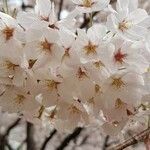Deciduous, spreading to erect tree, 4-12-(15) m high when mature, not armed; trunk tall. Lf petiole (14)-20-32-(40) mm long, glabrous or occasionally with sparse hairs; blade usually thin, usually broadly ovate to broadly elliptic, occasionally oblong or narrowly obovate, (70)-80-130-(155) × (40)-45-60-(65) mm, acuminate to long-acuminate at apex, usually rounded to subcordate or occasionally cuneate at base, glabrous above and below, with lower surface slightly paler, serrate with teeth aristate and often gland-tipped; stipules long-triangular, early deciduous. Infl. a corymbose cluster of (2)-3-4-(6) fls, on short lateral shoots, sometimes clustered near branchlet tips, up to 45-(80) mm long, ± pendent; fls not fragrant; pedicels (10)-14-(35) mm long, glabrous, subtended by serrate bracts. Hypanthium narrowly campanulate; sepals 4-7-(8) mm long, lanceolate or subulate, acuminate, glabrous, greenish to magenta, erect to spreading or occasionally reflexed. Petals 5 or many, ± spreading at anthesis, broadly obovate to orbicular, (12)-14-18-(20) × 9-14 mm, undulate and notched, white or pink-flushed to rose. Stamens < petals; filaments whitish or flushed pale pink. Fr. < 15 mm diam., globose, glabrous, black-purple, bitter; stone smooth.
More
A small tree. It has wide spreading branches. It grows 3-4.5 m high. The bark is brown and ringed with breathing pores. The leaves are oval. There is an abrupt tip and rounded base. There are sharp teeth along the edge. The flowers are white or pink. They occur in large clusters. The fruit are small and black.

